 Vintage postcard of the neighborhood from the Santa Monica Public Library
Vintage postcard of the neighborhood from the Santa Monica Public LibraryIn 1924 or thereabouts, a couple of real estate developers started selling lots on a cliff overlooking the Pacific Ocean north of Santa Monica. The beach here is narrow and rocky, with a large conical formation people called Castle Rock jutting out into the surf. The developers envisioned a Mediterranean seaside village, and called it Castellammare, meaning "Castle on the sea."
They named the streets that wound and switch-backed up the cliff after other Mediterranean cities, and there were rules that said all construction had to be in a style that imitated Italian Renaissance architecture.
 Leon Kauffman's Villa
Leon Kauffman's VillaThe first house in the new development was a
huge villa built by wool magnate Leon Kauffman, who bought six lots to accommodate his dream house. It sat high above the ocean, its grounds landscaped and terraced, its gates overseen by statues of naked ladies. Other wealthy buyers followed, including film director Roland West, whose Castillo del Mar compound ranged up and down the hillside. Another Castellammare house was bought by actor John Barrymore - it was rumored to be the love-nest where he romanced Mary Astor.
A single commercial building with space for shops and a cafe was built at the entrance to the development from what was then called Roosevelt Highway, today's Pacific Coast Highway.

This WPA land use map from 1934 shows the series of walkways and promenades threading their way up the hills and down tot he beach. The yellow marks indicate houses, and the red marks indicate commercial establishments, including a real estate office and the cafe itself. At the cafe, an arched bridge allowed residents access to the beach without crossing the busy highway.

In the book
"Secret Stairs - A Walking Guide to the Historic Staircases of Los Angeles" by Charles Fleming, Walk #40 takes us through the Castellammare neighborhood. We walked it on a recent foggy Sunday morning.

We parked on the side of the highway near the bridge, and crossed over. The bridge allowed a peek at balconies and hillside terraces off the upper floors of the cafe building, which now houses a Catholic film production company. They were clearly occupied, since furniture and cushions were arranged outside - so we didn't want to pry, but we were still curious, because this building has a
mysterious history.
In August, 1934, actress Thelma Todd went into business with another film industry partner, director Roland West, and opened Thelma Todd's Sidewalk Cafe in this building. She lived in one of these apartments above the cafe.
She was a cute blonde with a nasty ex-husband and a mobster for a boyfriend. She had a taste for wild life, drinking and - maybe - drugs. In December, 1935 she went to a party, stayed out too late, and was found dead two days later, slumped behind the wheel of her car which was parking in a garage up the hill. Despite a lot of contradictory evidence, her death was ruled a suicide by a Grand Jury.
 The blue doors lead to the apartments above the Cafe
The blue doors lead to the apartments above the CafeAs we walked through the passage between the house and the neighboring property, we knew we might be retracing her steps on that fateful night. Todd's hired chauffeur had dropped her off that night. The official theory was that she found the door to her apartment locked, and so she climbed the hillside to the garage.
Perhaps it was this mysterious crime that inspired Raymond Chandler a few years later to set a scene from his novel
"Farewell, My Lovely" in Castellammare.
 Stairs rising from Castellammare Drive to Posetano Drive
Stairs rising from Castellammare Drive to Posetano DriveWhen Phillip Marlowe goes to meet a mysterious client, he describes the scene like this:
Above the beach the highway ran under a wide concrete arch which was in fact a pedestrian bridge. From the inner end of this a bight of concrete steps with a galvanized handrail on one side ran straight as a ruler up the side of the mountain. Beyond the arch the sidewalk cafe...was bright and cheerful inside, but the iron-legged tile-topped tables outside under the striped awning were empty save for a single dark woman in slacks who smoked and stared moodily out to sea, with a bottle of beer in front of her. A fox terrier was using one of the iron chairs for a lamppost....
I...started up the steps. It was a nice walk if you liked grunting. There were two hundred and eighty steps up to Cabrillo Street. They were drifted over with windblown sand and the handrail was as cold and as wet as a toad's belly.
When I reached the top, the sparkle had gone from the the water and a seagull with a broken trailing leg was twisting against the offsea breeze. I sat down on the damp cold top step and shook the sand out of my shoes and waited for my pulse to come down into the low hundreds. I shook my shirt loose from my back and went along to the lighted house...
The first set of steps land on Castellammare Drive, and then you take a short jog to the left to the foot of the next set of steps. Jack had joined us on the walk. He used a lamppost as a lamppost, then we started up to Posetano Drive.

This hillside is unstable, and the neighborhood has been plagued with landslides since the beginning. In the 1950s a big slide brought the roads and the staircases down with the houses, so that just east of the sidewalk cafe, Castellammare, Posetano, and Revello drives all come to a dead end, cutting off access to the east side of the neighborhood.

Our walk takes us west, past a stairway that leads to nowhere - the system of promenades tumbled down the hill decades ago.
As we round the curve we can see ahead of us the high ridge of the mountain crowned with a large mansion cantilevered out on the cliff. Before we get there, another flight of steps on our left takes us back down to Castellammare again. Then we walk down Breve Drive to Porto Marina, which rises up from the cafe. Here on one side is a '20s era home with a tile plaque saying it was designed by noted architect Paul R. Williams.
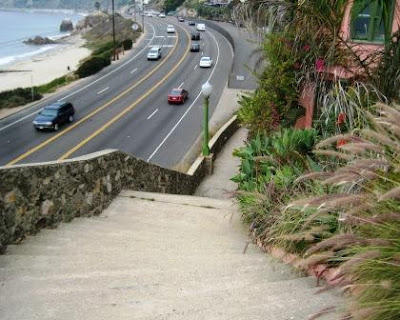
Across the street, a broad flight of steps skirts a rambling pink house, down to the highway.

This vintage postcard from the Santa Monica Public Library shows the same flight when the promenades were new.

Back up Porto Marina past a home with wonderfully playful sculptures on the garage door and railings. Then another steep flight up to Castellammare again.

From here we get a dramatic example of the instability of the cliff, as we skirt beneath the mansion we saw from up on Revello. The cantilevered tennis courts and gardens are impossibly shored up with huge concrete caissons and steel plates.

It looks like the bulwarks of a medieval fortress. Despite the imposing structures, the slope around it is littered with twisted railings, chunks of concrete, and rusted pipes that - clearly - are the result of the earth's continued heaving.
We walk a little quickly past the whole thing, as though it could fall down upon us at any moment.

Continuing on Castellammare, the slope rises quite steeply from the street. Here the homes are modern, and the bolstering of the hillside is more creative.

The views from this place are fantastic - but I'd always worry about my basement falling away. On the downhill side you can see a flattened empty lot where a house once stood, beside another public staircase landing that emerges from the earth where it was buried. We rise past another empty hump that once held a house, fenced and signed against trespassers, and then we pass a safe and stable old Mediterranean house - safe from slides, that is.
It's alarming for us, though because two giant Bouvier des Flandres dogs have sensed Jack's presence, and have gone into a slavering, barking frenzy behind their fence.

Following the book, we turn left at the intersection of Porto Marina Way and go take a look a Leon Kauffman's incredible mansion - now undergoing extensive repairs to keep it from tumbling down onto the highway.
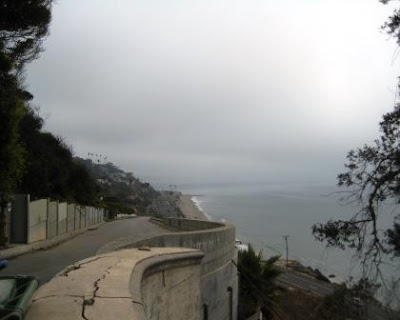 Beneath the Kauffman villa, Porto Marina Way curves back down to PCH
Beneath the Kauffman villa, Porto Marina Way curves back down to PCHThen we turn uphill again, and take Porto Marina to Vicino Drive, and climb huffing and puffing to Tramonto Drive.
Here, the homes are mostly modern - either '60s vintage ranch houses, or '80s vintage modern structures. The road is wide and freshly paved, and the street up here has a different feel from the lower, narrow curves. Tramonto is the street that runs along the crest of the cliff. As it peaks, we are now facing the mansion cantilevered over huge cylindrical caissons.
This house, hidden behind a gated wall, is said to be the estate of the actor Joseph Cotten, who appeared in Orson Welles' films. The house is under renovation, with exposed tarpaper walls prepared for re-stuccoing.
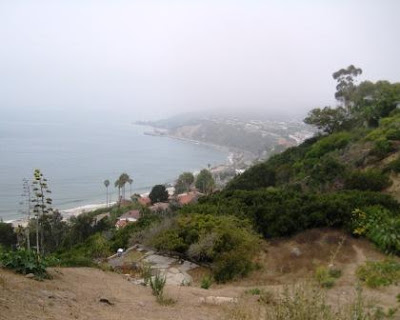
After we pass it and a few more modest homes, we come to a place where the road is buttressed and railed, and you can see below another landslide site, a shattered foundation. You can also see the incredible view of the curving coast.
We continue on Tramonto to where it meets Revello, and take a hairpin turn that doubles back down the side of the cliff. Now the landslides are above us. The road narrows over a one-lane bridge. We go on until we see the next staircase going down - but just beyond it is the upper part of the large gray villa that once belonged to director Roland West and his actress wife, Jewel Carmen - Castillo del Mar.

This vintage photo from the California History Archive shows in the foreground the Castillo del Mar under construction. You can see the Villa Leon on the distant hill and the mansion on the ridge. Posetano Drive winds unbroken through the neighborhood, and a long staircase runs down the hill from Tramonto Drive.

The stairs from Revello feed down to the road in front of the Castillo, Posetano Drive.

The Castillo, with its rustic barred windows, rounded turret and high stucco wall, is a formidable structure. The main house is above, but the two-car garage opens onto the intersection of Posetano and Stretto Drive.
The Castillo belonged to Roland West and his wife, Carmen Jewel, but the Wests were estranged, so Roland stayed in an apartment down in the cafe building. This is the garage - the one on the right - where Thelma Todd, West's partner in the restaurant, kept her car, a chocolate brown 1934 Lincoln Phaeton. This is the garage where her maid, Mae, found her on Monday morning, dead behind the wheel.
 Newspaper photo from the investigation into Todd's death
Newspaper photo from the investigation into Todd's death
As we contemplated the forbidding facade of the building, a fierce but small dog wearing a red bandanna poked his head out of the window above the garage and barked at Jack. He was so adamant that we decided not to linger and contemplate the scene, but continued down the curving street.
Below on Castellammare, three lovely 1920's era homes cluster together. On the uphill side, a large golden yellow house is wedged into a tiny lot within the switchback of the street. This house, according to a real estate listing a couple years ago, once belonged to actor John Barrymore.
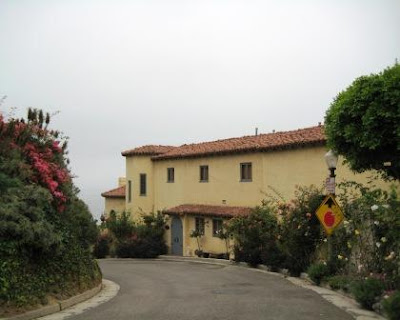
On the downhill side of the street, so far down the hill that from Castellammare Drive we were on level with its rooftops, is another old home, tile-roofed and embellished with wrought iron scrollwork, bracketed eaves, arched windows and fancy chimney pots. This house is fenced and gated, with alarming no-trespassing signs and even a security camera housed beneath a little tile-roofed post. It's more visible from the highway than here on the quiet street, although from here you can peek through an arched, locked gateway whose beauty is contradicted by the unwelcoming signs.
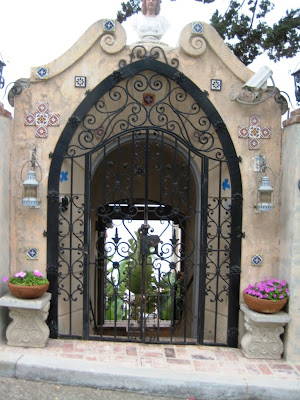
We walked past the signs to the end of the street, where the earth from decades-old slides has obliterated the road. A footpath winds through the scrub a short way to meet up with the western side of Castellammare Drive, and the steps that lead down to the footbridge. We've finished the walk.
It's amazing to see the effects of the earth's instability. In the early 90's a slide here destroyed almost a dozen homes. Yet these homes are valued - and sell - for millions of dollars. Beneath the monstrous earthworks holding up the mansion on Tramonto, a notice was posted announcing permits to build another house beneath it. The beautiful dream of living by the ocean still tempts people even in the face of potential disaster.
And what of Thelma Todd? We'll have to revisit her story later.






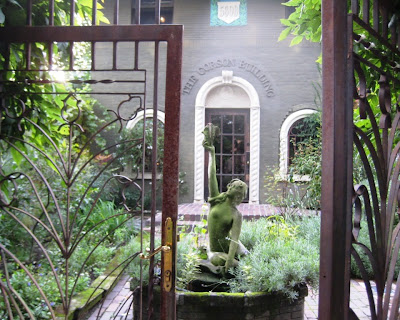

















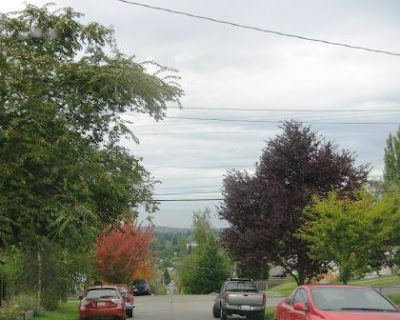








 In the book
In the book 




















